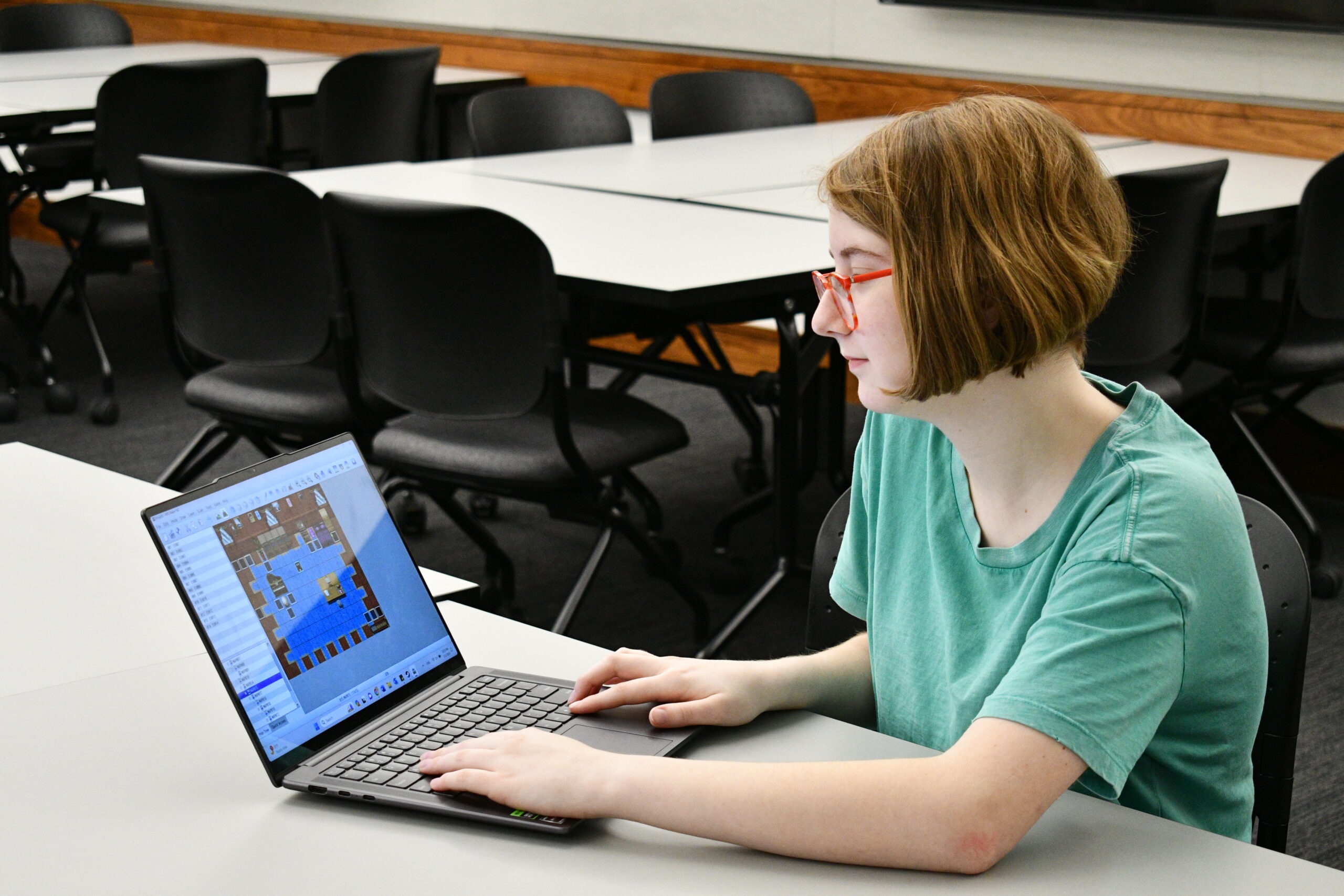Pfefferkorn works on her original RPG video game, “Echo, Repeat”, from her laptop. Photo by Elle Rotter.
JACK WILLIAMS | STAFF REPORTER | jrwilliams@butler.edu
It can be hard for college students to find the energy to pursue a hobby while navigating the constant demands of classes and clubs. Students are expected to consistently produce assignments for their professors and value for their employers.
However, there is value in working on a personal project during one’s free time. Students have found ways to build both mindfulness and community through their hobbies, whether they craft or code.
Junior biochemistry major Emma Edwards has fond memories of learning how to knit with her grandmother in elementary school. She rediscovered the joys of knitting over winter break and knit a sweater. Edwards continued to knit when she came back to Butler after break and hoped to explore different skills such as cable knitting and working with multiple colors. Knitting offered a way to challenge herself without the accompanying stress of meeting someone else’s demands.
“At the beginning of break, I wanted to knit a sweater, and that seemed really far-fetched,” Edwards said. “But there’s a million ways I can go about it. I can pick the color, the shape, the size, the design, all of those things. I can make the sweater I want to make.”
Rather than being overwhelmed by options, Edwards enjoyed the freedom to create the rules for her own work. This speaks to the importance of students having control over their own time. Butler students are unfazed by a heavy workload and a good challenge, as evidenced by the vibrant network of student-run clubs and events on campus. What wears students down is instead the fact that they are confined to someone else’s rubric or schedule 24/7.
First-year exploratory studies major Allison Pfefferkorn started working on a video game tentatively titled “Echo, Repeat” at the start of the fall semester. The player plays as a mynah bird who can only communicate by repeating what another character has said to them. She worked with the platform RPG Maker, a software designed to serve as an accessible one-stop shop for anyone who wants to create a role-playing game. She loved the variety of angles that she could approach the same project from.
“It’s nice to wind down with [making the game],” Pfefferkorn said. “Sometimes you get stuck on [part of the process] but it always feels good after you manage to figure it out. If you’re really drained and you don’t want to do something that intense, you can write dialogue or [create] a room for the next scene.”
There is a unique joy to the feeling of being lost inside of a passion project. Minutes and hours blur together, and all of a sudden the distinction between the person and what they are working on seems to vanish. The multiple facets of a video game, from the art to the story to the logic puzzles, provide different ways to access the same space of mindfulness that Edwards feels when she focuses on every stitch of a sweater.
Pfefferkorn’s love for puzzles stems from older RPG Maker games and family trips to escape rooms. Her current project is informed by her past experiences and the community that surrounds the genre. She hopes to publish “Echo, Repeat” when she finishes it, and engage with the RPG Maker community as both a consumer and a creator.
For Macy Cansdale, a senior youth and community development major, the connections make the craft. Sharing the beaded jewelry and keychains she makes is the best part of the creative process. The thrill of securing a new set of beads to choose from is matched only by seeing the kids she works with as a summer camp counselor enjoying the creations she brings for them.
A fruit-themed necklace Cansdale made. Photo by Elle Rotter.
“It’s a fun way to get [campers] into crafting and a good way to connect with kids,” Cansdale said. “I wear this [fruit] necklace every day. Anytime I’m substitute teaching or at my internship kids [will say], ‘Oh my gosh, that’s so cute.’ That always warms my heart.”
Cansdale started working with beads her sophomore year, after a trip to the West Lafayette bookstore Von’s with her sister. She was drawn to the bead section, and soon after began making keychains before moving on to other mediums. Now, her friends can frequently be spotted with her handiwork around their wrists or hanging off their backpacks.
Cansdale is not resting on her beaded laurels, either. She has set herself creative goals for the summer.
“I’m pushing myself outside of my comfort zone and trying to think of other cool things that I could make,” Cansdale said. “I’m also [working on] getting my bead collection up for camp before the summer so that my campers can craft to their heart’s content.”
The common theme between the projects of Edwards, Pfefferkorn and Cansdale is that they take their projects one step at a time. Each stitch, storyline and bead is important. It is worth it to be mindful and appreciate those smaller moments rather than rushing toward a grand conclusion. The sight of a finished product is wonderful, but there is just as much satisfaction to be found in the little victories that are achieved every day.
The lessons learned from these pursuits apply to academics and professional life, too. Creative projects do not need to be formulated around a product that can build a resume in order to be beneficial. Amid the hustle and bustle of college life, there is nothing wrong with taking a creative time out. Edwards summed up the refuge that a creative project provides from that world.
“Having that space where I’m in control of my thoughts [and] I’m in control of what I’m doing [is important],” Edwards said. “No one needs anything from me for these 10 minutes. And if they do, they can wait.”




